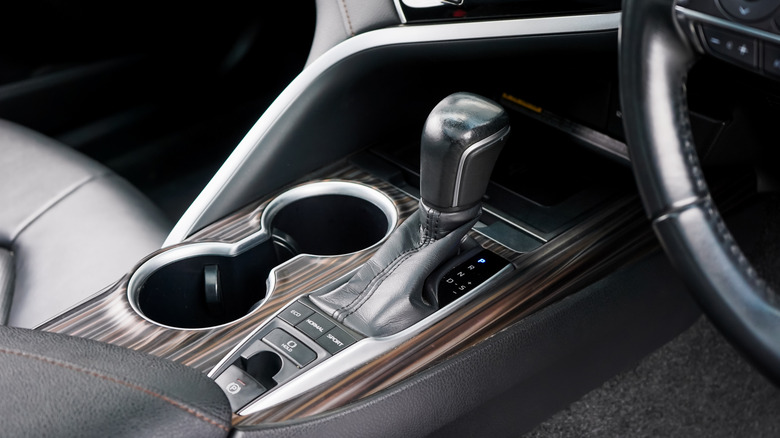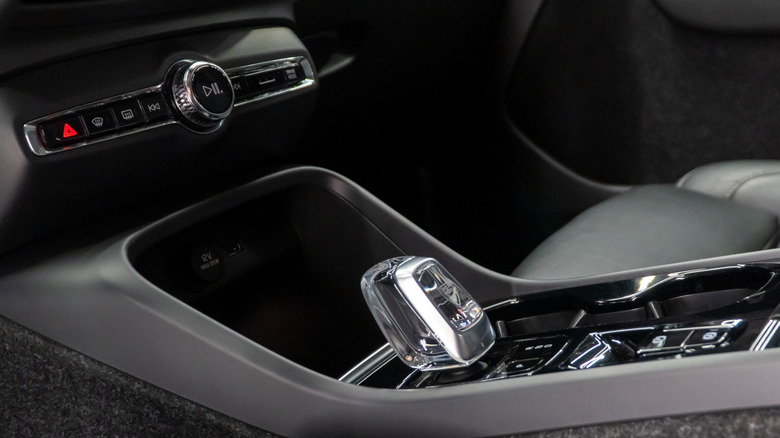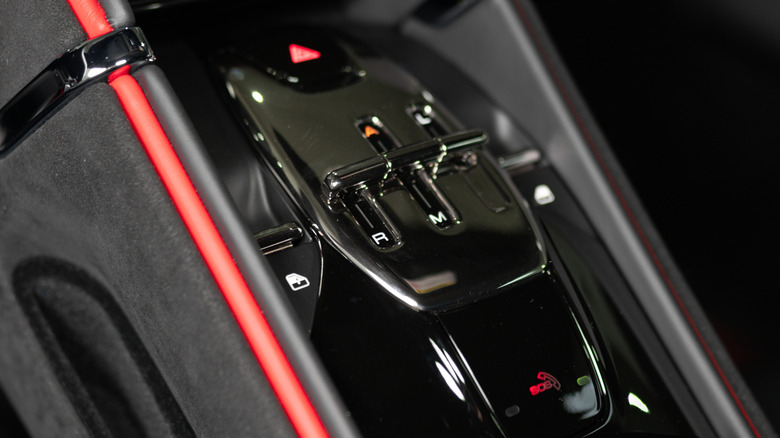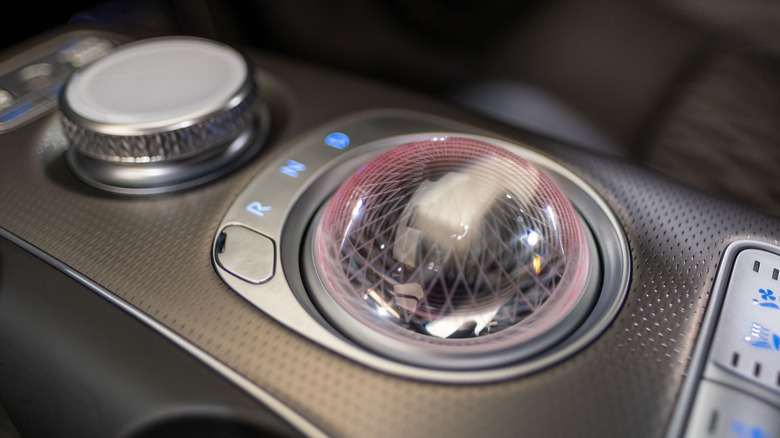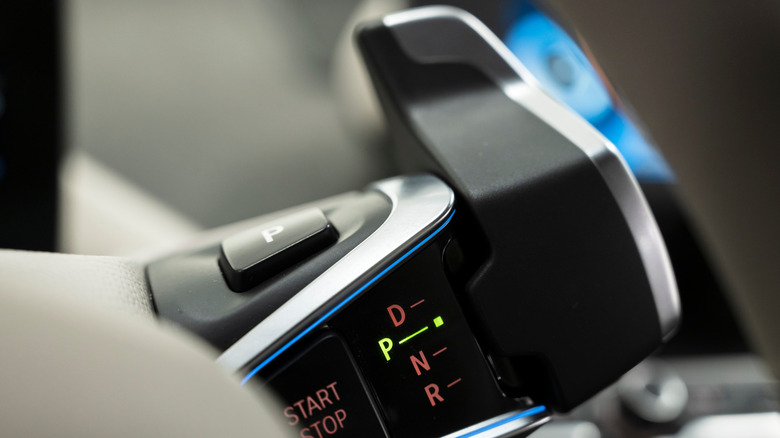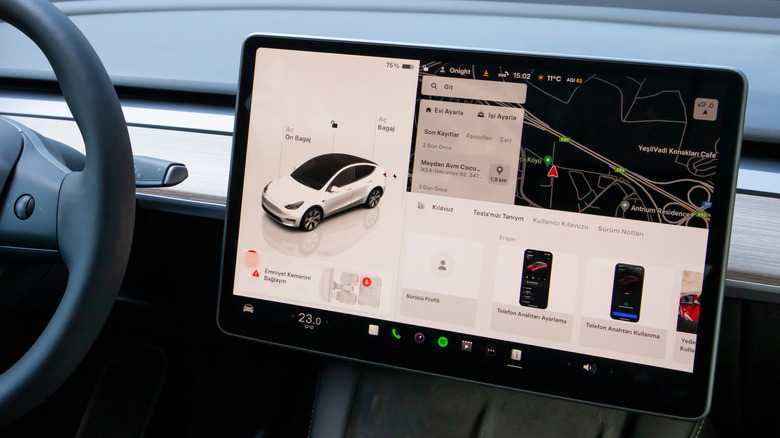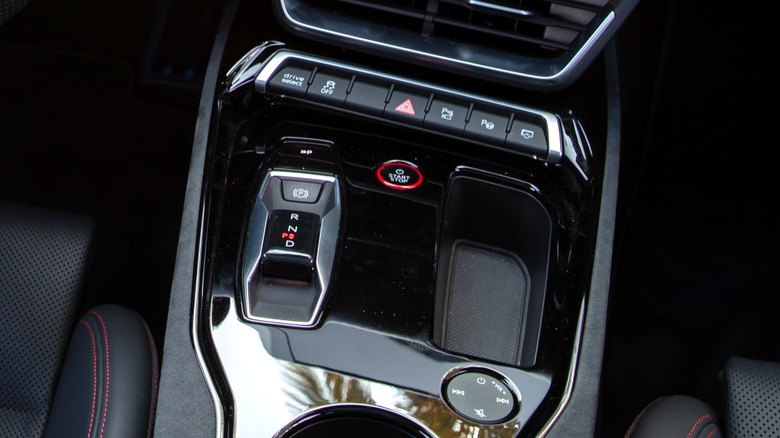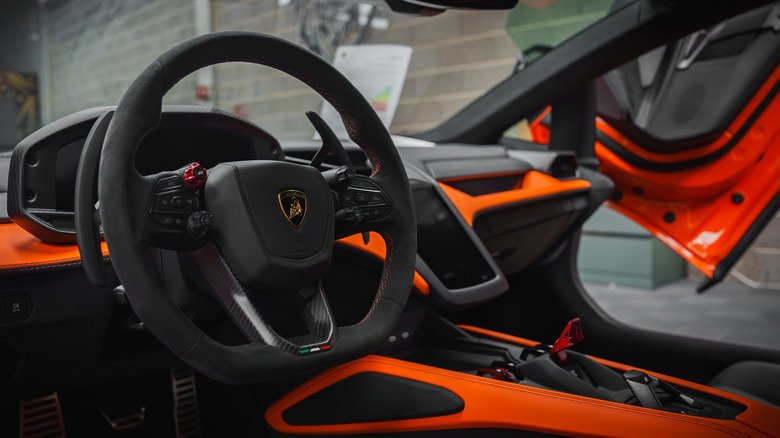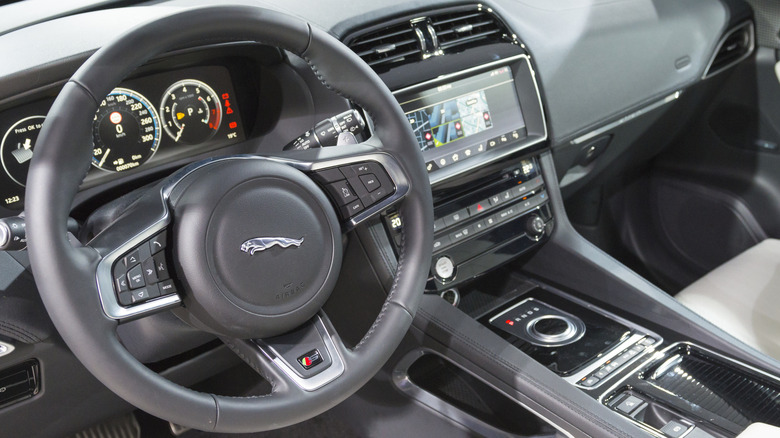10 Of The Weirdest Gear Shifters Fitted To Modern Cars
Many things have changed since the first automobiles rolled off of the production lines. In the beginning, most cars followed a relatively similar formula in terms of design both inside and outside. As we got more and more proficient in building our people-carrying companions, different automakers started to branch out and add features and flourishes to make their cars their own. Headlights, wheels, grilles, door mirrors, and everything else started to gain their own DNA as brands went further and further to differentiate themselves.
Today engineers and designers have more freedom than ever to experiment with their creations — even with seemingly straightforward components like the gear shifters. Shifting gears is a critical aspect of operating a car and the way a driver interacts with the transmission is one of the most frequent contact points beyond the pedals and the steering wheel. With automatic transmissions and electric cars, the engineering and design constraints become loose and many brands take this opportunity to make their mark. From dials to crystals to knobs and tabs, we've seen a wide range of options for gear lever alternatives.
Here are 10 of the weirdest and the most unique gear shifters fitted to modern cars.
Volvo Orrefors Crystal Shifter
Volvo is most closely associated with safety, but they also know luxury. The Swedish brand may not be as flashy or performance focused as some of its German peers like Mercedes, BMW or Audi, but their design language offers a minimalist and reserved form of Scandinavian-inspired luxury.
Volvo has the freedom to make its gear selectors in any format and material it wants. In the luxury car market, leather, wood, and carbon fiber are commonplace, so in order to stand out Volvo adopted crystal. Staying in touch with their roots, they commissioned Orrefors, a Swedish glassware house, to build a crystal shift knob for their model lineup.
First previewed in the Volvo Concept Coupe at the 2013 Frankfurt motor show, the Orrefors crystal shifter is ornate and unique. Though it may be a fingerprint magnet the crystal shifter certainly gives the Volvos it appears in a certain cool factor. When first introduced it was exclusive to just a few Volvo models, but now it serves as a light-bending focal point to the center consoles of many modern Volvos – including the Volvo XC40 that we tested in 2023.
Ferrari Roma Gated Automatic
There are a lot of things that make a Ferrari special, from the Rosso Corsa bodies to the engines built off decades of experience. However, one of the main things that makes a Ferrari so special is its heritage. Ferrari has been making dream cars since 1947 , and its racing pedigree has long mixed their racing DNA into their road cars. A key part of that DNA is a gated manual, and while Ferraris isn't selling cars with manual transmissions anymore, they don't want you to forget where they came from.
Unveiled in 2019, the Ferrari Roma opened the door to the next generation of Ferrari models alongside the SF90 Stradale. The Roma is something of a grand tourer coupe with a turbocharged V8 placed in a front mid-engine layout. Its design is meant to represent what Ferrari calls la nuova dolce vita. That translates to the new sweet life, which Ferrari used as a guiding principle for the Roma's development as they hoped to create a car that represented their history of design and character.
One way they've paid homage to their past is with the gear selector. The buttons work like tabs that can be pushed up or down to select gears, and they live in a metal enclosure that retains the gated manual shape of Ferrari's past.
Genesis GV60 Crystal Sphere
Originally created as a luxury offshoot of Hyundai, Genesis launched as an independent entity in 2015. In an industry where most of the big players have been around for decades, Genesis had to muscle their way into the market. One of the ways they tried to stand out was through the unique gear shifter included on models such as the Genesis GV60, a small crossover in the Genesis lineup. This was Genesis' first electric car, and to mark the occasion the designers fitted it with the so-called Crystal Sphere. The car industry has seen dial-like shifters before, but none matched the technical complexity or theater of the Crystal Sphere.
The way it works is similar to most other dial shifters. The driver can press the button in the center of the dial for park, or rotate it to the right or left to select drive, neutral, or reverse. When out of use, the dial transforms. It rotates into the center console and the other side reveals a crystal sphere. The sphere has a cross-hatched diamond pattern with accent lines that are lit up by the ambient lighting system. The whole contraption looks like it was stolen from an alien spacecraft, or Tony Stark's workshop. The Crystal Sphere may be a bit too much for some people, but it holds an undeniable cool factor.
Porsche 911 Shift Tab (922 Generation)
Similar to Ferrari, the Porsche brand is deeply connected to its racing roots, and their golden child is the 911. Having been around since 1963, the 911 has gained a reputation. For many, it's the final word in sports cars thanks to its timeless styling and smile-inducing driving dynamics.
So what makes a sports car a sports car? A lot of people might argue a manual transmission is essential, and while Porsche does offer a manual on a few select models, the rest come off the assembly line with an automatic. That's not all bad news though, because the Porsche DoppelKupplung (PDK) is about as good as it gets when it comes to automatics. Beyond the wheel-mounted paddle shifters, though, the way you interact with a Porsche PDK is a little dull.
On the current 992 generation 911, rather than having a lever, or a knob to change gears, Porsche gives customers what can be best described as a tab. This small, flat switch looks like a forgotten USB stick the engineers left in the center console. For a car so focused on user experience and tactile feedback you'd think the gear selector would have a bit more oomph to it. It almost feels sacrilegious to see a 911 without some sort of shift knob in the middle but luckily for Porsche, the PDK's absurd speed and fluid shifts make it easy to forget any qualms you may have with the gear selector.
Pagani Utopia Exposed Manual
Pagani is one of the few hypercar brands that truly chases beauty rather than top speed records or Nürburgring lap times. Their cars are more Michelangelo than they are Einstein and nothing exhibits this affinity to grace and glamor quite like their interiors.
One of the highlights of the Utopia's predecessor, the Huayra, was its exposed sequential gearbox. Although this sequential preserved the look and part of the feel of a manual, it wasn't the full experience. Rather than having set positions for each gear, the driver could pull the lever forward or backward to shift up and down the gear range. Pagani further experimented with this tech in the Huayra Epitome, a one-off special sendoff for the Huayra which featured an exposed gated manual transmission.
They were clearly proud of this feat of engineering and artistry, because when the Utopia was unveiled, clients had the option to spec an exposed gated manual similar to the one found in the Huayra Epitome. The assemblage stands tall between the driver and passenger's seat, coming together into a piece of craftsmanship tasked with transmitting the Utopia's 852 horsepower. In a world full of automatics a manual is a special sight, and the Utopia's manual is a celebration of mechanical finesse and the synthesis of car and driver. It's no wonder 70% of Utopia buyers opted for a manual.
BMW i3 Shift Knob
When the BMW i3 premiered in 2013 it indicated a new step for BMW. It was the first fully electric vehicle from the German brand, and it debuted a smooth and sterile design language of a possible future. The i3 launched alongside its big brother, the i8. Although their general shapes and missions were different, the i3 and the i8 actually shared a lot in common. On the outside they both kept the iconic kidney grille and angel eye headlights with some futuristic design flourishes. Although the BMW i3 is now discontinued, it debuted a handful of new and interesting ideas for the brand.
One of those new ideas on the interior was the i3's gear shifter. Everything looked new and enhanced but familiar with a curvy gear shifter mounted in the center console. The i3, on the other hand, featured some new ideas and looks for the inside space. The steering wheel had two spokes instead of three, and the dash sat flat and high.
Since the i3 was electric, there was no need for a traditional raised gear tunnel down the center, which meant the gear lever was nowhere near the center console. Instead, drivers were able to shift gears using a knob sticking out of the steering column. The knob can look a little odd from some angles, but it keeps the gears along with the start/stop button within inches of the driver's hand.
Tesla Gear Change UI
Continuing with the electric car theme, we move onto a brand centered on electric powertrains and tech. Tesla is known for their extremely simple and sterile interiors. The lines are straight and the climate control vents are integrated into the design. Generally, getting into a Tesla feels more like stepping into a new Apple store than it does a car interior.
There's a lot of debate in the car community about the industry-wide transition from physical buttons to screens, but most cars have a balance of both. Tesla however, leans very heavy into the screen side. Almost everything is integrated into the car's infotainment system, which is controlled using the massive center screen in the middle of the dash and that includes shifting gears.
The center screen is the driver's main point of interaction with the car and some functions take a bit of navigation through different systems menus. Luckily, though, Tesla made the shifting process as accessible as it can be for being done through the touchscreen. When drivers have their foot on the brake and are ready to shift gears, a vertical sidebar menu appears on the left edge of the screen. Although this side menu is not visible at all times, the driver can still access it at any time by swiping at the left edge of the screen. From here, the driver can select different gears by swiping up or down, or by tapping their icons.
Audi E-Tron GT Toggle Switch
The clear theme here is that when a car is electrified, designers get some extra freedoms when building interiors and interface systems. They no longer have to conform to layouts that are constrained by the technical necessities of a car powered by an internal combustion engine, and the Audi E-Tron GT is an excellent example of this in practice.
The E-Tron GT is a four door sedan that's supposed to produce capable performance numbers, but also to exude luxury. The interior follows this mission in classic Audi fashion, with an understated but elegant design and high quality build materials. Everything the driver touches should have a sense of weight and occasion to it in a car at this price bracket, and that includes the gear shifter.
With the E-Tron GT, Audi tried something new. Most modern Audi models feature a well done — if a bit boring — gear lever. As an electric halo car though, the E-Tron GT disposes of that old fashioned tech. As a replacement, the E-Tron GT uses a sort of toggle switch. It sits in an indented valley in the center console as a flat tab. To use it, drivers can slide the tab up or down depending on what gear they want to select. It may look strange, but it's an intuitive replacement for the more classic gear lever.
Lamborghini Revuelto Button Array
Lamborghini has always been about aggression and excess. Their V12 flagships like the Murcielago and the Aventador have exemplified this philosophy for years and now, there's a new addition to the Raging Bull's lineage – the Lamborghini Revuelto. The Revuelto features a hybrid powertrain, producing a bone-crushing 1,001 horsepower. Outside, it wears the brand's angular and angry design language with pride. It looks like a piece of experimental military tech and the story is the same inside.
If you find yourself in the cockpit of a Revuelto, you'll see you're surrounded by sharp, blade-like paddles and buttons. On the center console — behind the start/stop button which looks like it might fire a missile — there's an array of buttons to select gears. The park and manual drive modes are on pointed buttons, and the reverse gear is on what looks like a miniaturized airplane thrust control lever above the two buttons. To select drive, you simply pull once on the upshift paddle.
This array will have you looking like a fighter pilot doing a startup sequence every time you parallel park. Unnecessary? Sure. Cool? Definitely.
Jaguar F-Pace Dial Shifter
British cars are loved by many for their performance and character. Bentley, Rolls Royce, and Jaguar are the quintessential brands of British class. Take Jaguar, for example. In their heyday they were known for masterpieces like the legendary E-Type, but how do they hold up today? Even for a brand who historically focused on sports cars, they haven't been able to resist the market demand for bigger SUVs and crossovers.
In 2016, Jaguar met this demand by introducing the F-Pace. The F-Pace was powered by a supercharged V6, and it brought the design language of their sedans like the F-Type, XF, and XJ to the SUV world. This was new territory for them, and with it they wanted to introduce some new features.
One of these features was a new gear shifter. The F-Pace featured a dial shifter that removed any need for a bulky lever taking up space in the center console. In theory, a dial shifter is simple and easy to use, but Jaguar decided to complicate things. Similar to the Genesis GV60's Crystal Sphere, the F-Pace's dial shifter would retract to be flush with the center console when not being used.
This was a cool feature, but it proved a bit finicky for owners. It's a fun and luxurious function, but the technical complexities proved to be prone to malfunction and hard to fix. To remedy this, the 2021 F-Pace got rid of the pesky dial in favor of a more traditional shift knob.
